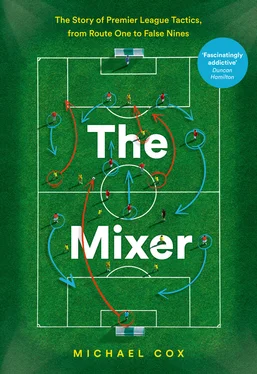In the home dugout at Wembley that sunny afternoon was Bryan Robson, then acting as assistant to England manager Terry Venables in addition to his role as player-manager of Middlesbrough. Mesmerised by the opposition number 10’s performance, Robson convinced Middlesbrough’s board to sign Juninho, beating the likes of Arsenal, Inter and Porto to the Brazilian’s signature. Middlesbrough chief executive Keith Lamb referred to his new recruit as ‘the most sought-after player in the world’. Hyperbole, certainly, and somewhat undermined by the fact that Juninho cost less than Middlesbrough’s other major arrival that summer, Nicky Barmby, but this was a landmark purchase, a rising player joining a rising team in a rising league.
His unveiling was a huge event in Middlesbrough. Fans greeted him at the airport with Brazilian flags, more cheered as he arrived at the new Riverside Stadium in scenes reminiscent of a papal visit, then 6,000 moved inside to watch him play keepy-uppies with Robson. His first press conference didn’t pass without one inevitable question. ‘Does he know how cold it gets in Middlesbrough in January?’ asked one journalist. Juninho, through a translator, insisted it wouldn’t be that bad, although he was often criticised by pundits for playing in gloves, and during his first winter stuffed newspaper inside his boots in an attempt to keep his feet warm. Robson responded by describing Juninho as a ‘tough character’ – and most top-class Brazilian attackers are. The cliché about Brazil suggests it’s non-stop samba football, played by technical players who learn their trade playing on the Copacabana. Realistically, the Brazilian top flight is extremely aggressive: it’s not simply that defenders kick attackers ferociously, it’s that referees allow it, and so Juninho’s transition from Brazilian to English football wasn’t as tough as many anticipated.
Immediately afforded a free role by Robson, Juninho used that licence fully on his debut against Leeds, starting on the right flank before quickly drifting across to the left. He played two killer through-balls inside the first half, setting up Jan Åge Fjørtoft for the opener. Inevitably, Leeds’s response was to kick him, and both Carlton Palmer and John Pemberton were booked for fouling the Brazilian. The Independent ’s match report remarked upon his ‘surprising courage’ and ended with an acknowledgement that ‘perhaps he is tougher than anyone thought.’ Indeed, his final significant contribution before being substituted was a thundering tackle on legendary crossbar-botherer Tony Yeboah, one of the Premier League’s most powerful players, which earned a booking. That went down well, as fans wanted proof he would get stuck in.
A fresh-faced, slender creator whose name meant ‘Little Junior’ – so small they named him twice – the Brazilian wasn’t expected to thrive in English conditions, but Juninho loved the north-east and loved English football. The club found him a house in Ingleby Barwick, a large housing estate, and he moved in with his entire family, which helped him settle. Juninho’s house became something of a local landmark, with children queuing outside for his autograph. His mum made them cookies, and Juninho wasn’t averse to the occasional kickabout in the street.
Juninho was tricky but direct in possession, efficient with the ball rather than a showboater. He was an instant hit, and unquestionably in the class of the aforementioned number 10s, later playing a significant role in Brazil’s 2002 World Cup triumph. In Juninho’s second season, Alex Ferguson described him as the Premier League’s best player and later considered signing him. His finest moment in English football arrived during that campaign, a 1–0 home victory over Chelsea in March. He outshone Zola and created a succession of chances, wasted by Craig Hignett and Mikkel Beck. Eventually, he settled things himself. Receiving the ball wide on the left, he slalomed between Wise and Di Matteo and evaded a desperate lunge from Chelsea’s third central midfielder, Craig Burley, before slipping the ball into the left-hand channel for Beck. The Danish striker paused, and then chipped the ball into the box for a perfect diving header from – of all people – five-foot-six Juninho. The Brazilian magician wasn’t simply performing the duties expected of a Brazilian number 10, outwitting the entire opposition midfield, but also the duties of an English number 9, beating Chelsea’s centre-backs to score a header. ‘I don’t know what Juninho’s running on at the moment,’ Robson said afterwards. ‘He isn’t looking tired, he’s keeping pace with the game – and he’s tackling back!’ Make that the qualities of an English number 4, too.
In his second season Juninho was handed Middlesbrough’s number 10 shirt, having worn 25 in his debut campaign, and was also named the Premier League’s Player of the Season. Admittedly not as prestigious an award as the PFA or FWA Player of the Year, it was nevertheless an acknowledgement of his great influence. And yet, staggeringly for one of the league’s most revered players, Juninho ended the campaign sobbing on the pitch as Middlesbrough were relegated.
Basing the side around Juninho didn’t pay dividends. When Juninho made his debut for Middlesbrough in November 1995, the Teesiders were sixth, having lost to only the two title challengers, Manchester United and Newcastle. Despite Juninho’s impact, their form nosedived dramatically. They were atrocious in the second half of the season, winning just two of 19 matches. They finished 12th, but in points terms, were closer to relegation than 11th.
The 1996/97 relegation campaign was also strange for Middlesbrough. They reached both the League Cup and FA Cup finals, losing to Leicester City and Chelsea respectively – a devastating double blow for a club that had never won a major honour (although Juninho would later help them to League Cup success seven years later, then into his third spell on Teeside – he simply couldn’t stay away). Granted, Middlesbrough’s relegation was partly because they were deducted three points for withdrawing from a December fixture at Blackburn when half their squad had been wiped out by flu, but you can’t ignore the fact that they had the division’s worst defensive record. There were also major problems in the dressing room, particularly involving star striker Fabrizio Ravanelli, a divisive influence. He once interrupted a team meeting with a lengthy rant in Italian about wanting to leave, and had a fight with Neil Cox before the FA Cup Final after the right-back suggested Ravanelli wasn’t fit enough to start. ‘Half the squad hated him and the other half loved him,’ said Hignett. ‘He was one of the best finishers I’ve seen, but he rubbed people up the wrong way. He was selfish in everything he did.’
Meanwhile Juninho, while individually brilliant and very popular with teammates, caused Middlesbrough problems. Like Cantona, Bergkamp and Zola, he thrived in space between the lines, but was a different type of footballer. An advanced midfielder rather than a withdrawn forward, he ventured into deeper positions to collect possession. He therefore wasn’t suited to a deep-lying forward role in a 4–4–1–1 like the aforementioned players, and Robson constantly changed his shape in an attempt to base the side around both Juninho and Barmby, deploying 4–3–2–1 or 3–4–2–1 in his first season. It didn’t quite work defensively, and getting the best from two players between the lines was difficult. Both Juninho and Barmby had a better relationship with the underrated Hignett, and Barmby departed after 18 months for Everton, leaving Juninho as the sole creator. His form improved, and a 6–1 thrashing of Derby demonstrated Middlesbrough’s potential. ‘I am now playing as well as I ever did in Brazil, but I think that is because I have found my best position,’ Juninho said. In other words, the system was based around him.
Читать дальше












